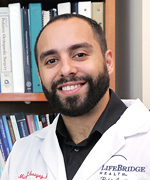Hemihypertrophy (Overgrowth Syndrome)
What is hemihypertrophy?
Hemihypertrophy is a condition where one side of the body grows more compared to the other side of the body. It is also known as overgrowth syndrome or hemihyperplasia. The differences in sides of the body may be significant or subtle, and the condition typically affects the upper extremities (arms), lower extremities (legs), and the facial features. Hemihypertrophy needs to be differentiated from hemiatrophy, in which one side of the body is underdeveloped. This distinction is usually made based on whether upper and lower extremities are both affected; hemihypertrophy generally affects both, while hemiatrophy does not. Hemihypertrophy comes with increased risk of tumors, while hemiatrophy often requires workup for other neurologic pathology. From an orthopedic perspective, the two conditions are treated similarly as limb length discrepancies.
What causes hemihypertrophy, or is the cause unknown?
Hemihypertrophy may or may not be associated with a specific genetic syndrome. When it is not associated with a genetic syndrome, the cause is usually unknown. Beckwith-Wiedemann syndrome is one cause of hemihypertrophy. Beckwith-Wiedemann syndrome is caused by an abnormality in chromosome 11 which results in the differential growth between sides of the body. Even in cases where the hemihypertrophy is caused by a chromosome 11 abnormality, most cases are sporadic, meaning that the cases occur by chance. These chance cases are not passed down from family members and may or may not be passed on to future children.
How common is hemihypertrophy, if known?
Beckwith-Wiedemann syndrome is the most common subtype of hemihypetrophy, and occurs both in boys and girls equally in approximately 1 in every 11,000 births. However, causes of hemihypertrophy not associated with this syndrome, mild cases that are never officially diagnosed with this syndrome, or other over growth abnormalities associated with chromosome 11 add to this number.
How is hemihypertrophy diagnosed?
Hemihypertrophy is diagnosed by observing the asymmetry–differences in growth between one side of the patient’s body and the other. There is no specific test for hemihypertrophy, however, children with an apparent difference in their side to side size should be evaluated for Beckwith-Wiedemann syndrome. Other non-orthopedic features of Beckwith-Wiedemann syndrome which be observed are a large tongue, creased earlobes, enlarged solid internal organs (liver, pancreas, kidney), defects in the abdominal wall and low blood sugar.
Genetic testing may be helpful to confirm the sub-type of hemihypertrophy. However, other tests are important in children with this diagnosis. The changes in growth in the organs places children with Beckwith-Wiedemann syndrome and other hemihypertrophy syndromes at a higher risk of developing cancer in these organs. For that reason, regular ultrasounds of the abdomen as well as blood work up for tumor marker alpha-fetoprotein is recommended until age seven.
What are the treatment options for hemihypertrophy?
The treatment required for hemihypertrophy depends on how much difference exists between the sides of the body. Most commonly, the doctors at the International Center for Limb Lengthening treat difference in limb lengths. Small differences in leg lengths (up to 2cm) usually do not require treatment. For differences greater than this, it is beneficial to make the leg lengths more equal. This may be done with using shoe lifts or with surgery. Surgery to correct limb lengths can be done by lengthening the shorter leg using an external fixator or, if the bone is large enough, an internal lengthening nail. Surgery could also be performed to slow or stop the growth of the longer leg. This surgery, called an epiphysiodesis, can be closely timed while a child is still growing using the Multiplier app, developed by the International Center for Limb Lengthening. Deciding whether to lengthen a shorter leg versus slowing the growth of the longer leg depends on the patient’s goals.
For patients with hemihypertrophy, regular visits at about 6 month intervals to the International Center for Limb Lengthening clinic is important so that doctors can monitor how the limbs are growing. These visits will include an X-ray so that the bones in the leg can be measured and accurate predictions about the growth can be made to develop a customized treatment plan.
Why choose the International Center for Limb Lengthening for the treatment of hemihypertrophy?
Limb Lengthening is a complex process. Your doctor at the International Center for Limb Lengthening will take the time to make sure you understand all of your options and then will customize your treatment to meet your specific needs. Our patients benefit from our team-centered approach with world-renowned surgeons and specialized physician assistants, nurses and physical therapists. Physical therapy is a critical component of lengthening. Our physical therapists are among the most experienced in the world in managing the lengthening process. We help patients with hemihypertrophy achieve their best possible result.


